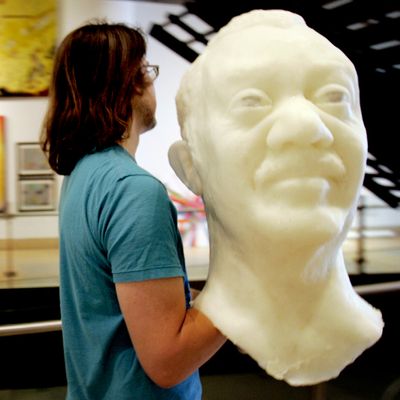
A year ago today, I wrote about the almost criminal cost of most Master of Fine Arts programs. ItÔÇÖs a year later, and things have only gotten worse, making these highly pricy, upscale programs all the more galling, as more and more students graduate owing this much money at this young an age ÔÇö the financial damages done by these schools has to be addressed.
Below is the text I wrote last year about this subject. ThereÔÇÖs not much to add except maybe to say state the obvious: A lot of the timid, judgment-averse writing afoot in criticism, as well as the snark adopted by those who were turned cynical in critical programs before they even had a chance to exercise belief, can be traced back to these posh programs. We need to find a way to stop dogmas from being taught and teachers from inculcating students with ideas that were fashionable 30 or 40 years ago, when the instructors were the studentÔÇÖs age. Not to mention that too many of those who teach in the actual art departments everywhere have these privileged positions based on doubtful credentials, long-ago, onetime accomplishments, or, in the case of a lot of men my age, only good-old-boy connections. These teachers get into these places, never leave, and rot institutions and unsuspecting students from the inside. SomethingÔÇÖs got to give, and not just by axing older teachers in an ageist purge. I hope that my griping doesnÔÇÖt just stem from my own teacher envy, never having gone to school or never having had a tenured job offered to me. Still, I say, students, beware: MFA programs are wonderful, possibly important things, even temporarily necessary in the art world we live in, but pay exorbitant tuitions at the peril of your artistic lives.
* * *
In┬áher excellent essay, now out in┬áModern Painters,┬áartist Coco Fusco pulls back the curtains on the risky business and chancy racket of the Master of Fine Arts degree. Fusco deftly addresses, among other things, how M.F.A. programs are ÔÇ£discursive battlefields.ÔÇØ Whatever that means, sheÔÇÖs right; I often have no idea what some teachers and students are talking about in group critiques. Her chief argument is financial: Fusco calls out skyrocketing tuition costs, massive student debt accrued ÔÇö more than almost any artist will be able to repay in a lifetime ÔÇö and shitty job prospects.
Amen. IÔÇÖm a dead-ender with no degrees, but I have been lucky enough to do a lot of teaching. I think itÔÇÖs great for young artists to go to grad school if theyÔÇÖve got the time, inclination, and money ÔÇö whether itÔÇÖs Mom and DadÔÇÖs money or a trust fund. Artists seem to thrive during these two years of enforced art-making, staying up very late and learning things with each other long after the professors have gone home for the night. New languages are incubated. But IÔÇÖve also witnessed ÔÇö and may have been responsible for ÔÇö a lot of bullshit. Iffy artist-teachers wield enormous artistic and intellectual influence over students, favors are doled out in power cliques. Zealous theoreticians continue to scare the creativity and opinions out their third generation of young artists and critics. Too many students make highly derivative work (often like that of their teachers) and no one tells them so. A lot of artists in these programs learn how to talk a good game instead of being honestly self-critical about their own work.
All this may be the same as it ever was. WhatÔÇÖs different now is that MFA programs are exorbitantly priced luxury items. At the top-shelf East Coast schools like Yale, RISD, SVA, and Columbia, the two-year cost can top $100,000. This doesnÔÇÖt include room, board, materials, etc. Add all that in, and youÔÇÖre hovering near a quarter-million dollars. No matter how wonderful the M.F.A. experience, thatÔÇÖs straight-up highway robbery. If well-off parents can handle it as one last extravagance, sure ÔÇö but weÔÇÖre now at the point where only the offspring of the very rich can attend these schools. All current grad students should ask their regular teachers a question: ÔÇ£Do you know what the base tuition for an MFA is in this program?ÔÇØ It borders on the blithe and unethical for them not to know.
Those of us who teach usually do so because we need the money; most of us also genuinely love the job. Still, if these programs are too expensive, we are a part of the problem, and need to change. (Although the larger issue may be that the schools treat M.F.A. students as cash cows.) This semester I took a one-third cut in salary and workload at the school where I teach, and it hurt a lot. Yet I think more schools have to consider doing this, and cutting tuition fees, and put┬áa lot┬ámore grant money at the disposal of their students. SomethingÔÇÖs got to give.
I used to teach regularly at three schools. I now teach at one, having resigned (amicably; I didnÔÇÖt have the time for all three) from Columbia and the School of Visual Arts. These are great schools, places where I got more from the students than I ever gave them. Yet my sense is that a lot of us teachers stay on the job for too long. IÔÇÖm all for wisdom, experience, and providing models for lives lived in art. Yet IÔÇÖm also struck by how often teachers get stuck in the era that┬áthey┬áemerged in, valorizing that past to impressionable students as a better, purer time, often pooh-poohing the present and sniping about other, younger teachers.
Longtime instructors ÔÇö like me ÔÇö might have their hours cut back to make room for newer teachers to take the stage. (This idea has been floated in several schools that I know of, and agreed to in principle with no follow-through.) Call me conservative, but itÔÇÖs also time for grad programs to stress courses in craft and various skills ÔÇö from blacksmithing to animal tracking, if these are things students need to learn for the visions they want to pursue. There should be a lot more art history in addition to all the current theory. Add all this to the secret knowledge that students are imparting to one another, make more grant money available, and grad programs will serve students rather than teachers and administrations. Especially if they can get the cost down.
Not only is it time to rethink the most expensive M.F.A. programs, itÔÇÖs time for applicants to bite the bullet and consider the enormous benefits of less expensive, less sexy-sounding schools that will leave them with much less debt. IÔÇÖve taught at institutions across the prestige spectrum. Truthfully? Students who go to high-profile schools get a subtle eighteen-month bump after they graduate, in part because dealers and collectors (oy) see their M.F.A. shows. However, once this short-term advantage dissipates, the artist becomes one in a crowd, with a mountain of debt, and may need to have a full-time job indefinitely to pay it off. ThereÔÇÖs no surer way to throw away that early advantage than getting a job that saps their art-making energy.
I believe that many of the less-expensive, non-marquee schools now have parity with ÔÇö and are sometimes better than ÔÇö the sexy top tier. Trust me; IÔÇÖve taught at them all. And should be fired.


